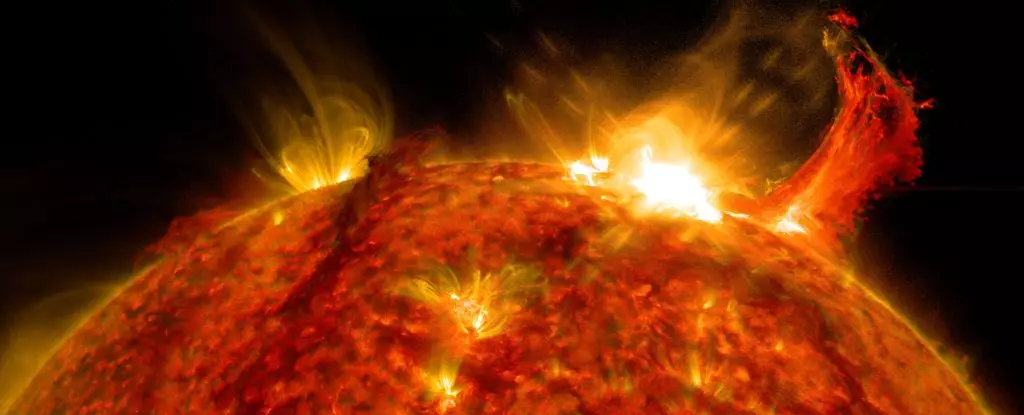Approximately 14,300 years ago, our planet experienced an extraordinary event, a colossal cosmic occurrence that is now etched into the fabric of Earth’s geological and biological history. Recent scientific inquiries have unearthed compelling evidence, suggesting that this massive event transpired around 12,350 BCE, prompting researchers to explore the ramifications and the mechanisms behind it. What makes this discovery pivotal is not merely its scale, but the impact it could have had on the climate and ecosystems of the time—a stark reminder of the sun’s volatility and the hidden perils of celestial phenomena.
Utilizing advanced climate-chemistry models, scientists have pieced together a narrative that indicates a monumental release of particles from the sun—a solar event unparalleled in its ferocity. The newly developed SOCOL:14C-Ex model has revolutionized our understanding of this ancient occurrence by allowing researchers to extend their analysis beyond the modern era, shedding light on the climatic implications during glacial phases. This kind of leap in our scientific toolbox is essential, as it opens avenues to understand how our planet has danced to the rhythm of cosmic forces long before the Anthropocene became the dominant backdrop of geological history.
The Solar Storm That Redefined Scale
What precisely made this solar event so extraordinary? According to researchers, this ancient storm was a staggering 500 times more intense than the most powerful storm recorded in the modern era—the 2005 particle storm. Such a comparison not only highlights the sun’s immense power but also raises questions about our preparedness in the face of future solar outbursts. Space physicist Kseniia Golubenko from the University of Oulu articulates a notion that transcends mere scientific curiosity; this event serves as a “new worst-case scenario” for future solar impacts on Earth.
Geomagnetic storms are typically precipitated by coronal mass ejections—sudden expulsions of plasma and magnetic fields from the sun’s corona. When these plasma clouds make contact with Earth’s magnetic field, the ensuing electromagnetic reactions set off a chain of effects that can disrupt modern technology and ecosystems. Historical instances, such as the Carrington Event of 1859, showcase the vulnerabilities of human innovation to such cosmic onslaughts. The 1989 storm further illustrated this susceptibility, resulting in widespread power outages. However, the implications of the 12,350 BCE event reach far beyond mere technological disruptions; they could have influenced climate systems and ecological dynamics in profound ways.
Carbon-14: The Cosmic Forensic Tool
Scientists have a compelling tool at their disposal to unravel the mysteries of the past: carbon-14. This radioactive isotope, produced when cosmic particles collide with atmospheric constituents, becomes integrated into living organisms. By analyzing spikes in carbon-14 levels found in ancient tree rings, researchers can pinpoint not just the date of geomagnetic events but also gauge their intensity. The evidence for the 12,350 BCE event relies heavily on these proxies from natural archives, enabling a story of cosmic interaction to be written with the help of ancient trees.
The research conducted on this spike in carbon-14 during the time period allows for the identification of a solar event that had eluded understanding for centuries. Besides this event, scientists are also studying similar phenomena dating back to 994 CE, 660 BCE, and 774 CE. However, this event stands apart from the others due to its placement outside the Holocene epoch, making it a unique case. The approach to understanding its impact through the SOCOL:14C-Ex model signifies a breakthrough in our methods to analyze paleoclimatic data under conditions that have long since passed.
The Legacy of Cosmic Forces on Earth
The consequences of such extraordinary solar activity are far-reaching. They do not merely linger in geological records; they shape the very essence of how we understand planetary resilience against cosmic forces. This new perspective brings to light the pressing need to revisit our strategies for mitigating potential risks associated with solar outbursts, especially as humanity’s reliance on technology deepens.
Moreover, the implications of the 12,350 BCE solar event challenge preconceived notions about the natural world’s stability. The planet has not remained in a serene balance; rather, it has constantly navigated the tumultuous interactions between solar and terrestrial elements. Understanding these dynamics enriches our appreciation of Earth’s history and prepares us better for what lies ahead in our solar journey. The sun, often viewed as a benevolent force, holds within it the chaotic potential to disrupt life on Earth—a reality we must acknowledge and respect.

